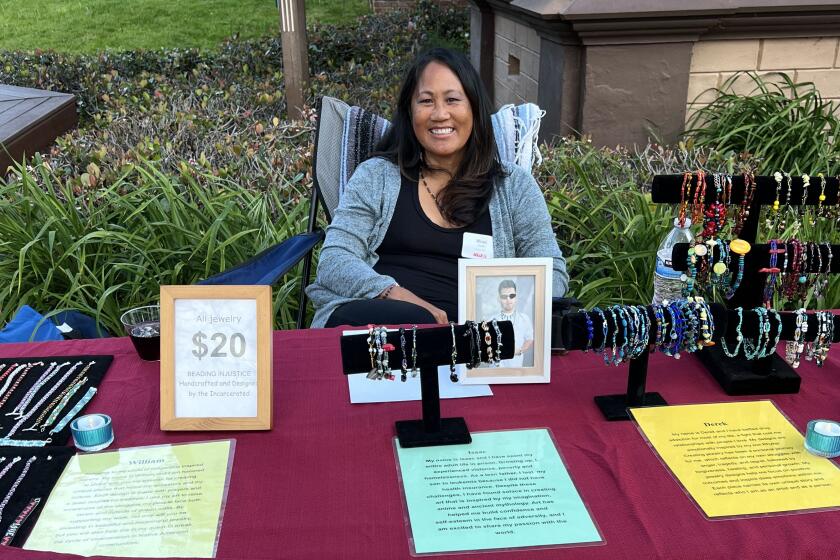La Jolla Historical Society to create ‘pocket park’ centered around MCASD pergola
In a win-win-win-win, the La Jolla Historical Society (LJHS) came up with a way to preserve a work by famed postmodern architect Robert Venturi, create a public pocket park, expand its permanent collection, and take something off the Museum of Contemporary Art San Diego’s (MCASD) hands ahead of its renovation project in La Jolla.
To bring all this together, LJHS took one of the two pergolas that once fronted the Museum and moved it to the Historical Society’s back terrace to ultimately provide a centerpiece around which a small park could be built at 780 Prospect St.
“There is much to do,” said LJHS executive director Heath Fox, enthusiastically. “We have to finish the reconstruction of the pergola; and landscaping work, including irrigation and drainage, so it will be a few more months before this will open to the public. We want to get it right and we want to it be beautiful.
“We had this space that was weeded-over and undeveloped, and we had the chance to do something with that. The sidewalk alongside the south side of our property leads to that space and there is nowhere to go — it used to lead down to Coast Boulevard but that is no longer the case — so all you can do is turn around. At the very least with this, the people who wander there will have a nice garden to walk through or sit in.”
The morning of June 13, the over-sized columns that surround the legs of the pergola were removed and the bare structure was lifted by a massive crane and moved from the MCASD campus to the Historical Society terrace. The move comes ahead of the MCASD renovation project later this year that will quadruple its current gallery space. The museum closed in early 2017 for the renovation.

“When I was first briefed on (architect) Annabelle Selldorf’s plan for the museum, it made a lot of sense,” Fox explained. “But I was worried about the fact that we had this very famous, late-20th century, postmodern architect and this was the only building he did in San Diego and we were going to lose the façade of that building. I was concerned about that, and at 3 a.m. one morning, it occurred to me we would salvage a fragment of that, and put it on an undeveloped terrace and make something the community can use and memorialize Venturi’s work here in La Jolla.”
Venturi, with his firm Venturi, Scott Brown and Associates, was behind MCASD’s 1996 renovation, and is the recipient of multiple American Institute of Architects (AIA) awards with buildings around the world. His work, according to Historical Society information: “represented a stylistic move away from the severity of the modernist steel-and-glass cube.” The pergolas were made of steel (where wood is they norm) and the columns are deliberately oversized to reflect the postmodern style.
The pergola’s lettering that reads “Contemporary Art” (a counterpart to “Museum of”), the asymmetrical 13 columns and a steel cantilever that juts out with no column underneath it, as Venturi designed it, will remain.
However, whether to preserve the pergola created a conundrum for the Historical Society’s preservation committee.
“The columns had never really been wildly popular,” said preservation chair Diane Kane. “They have their pros and cons, and apparently there were some of the (Museum renovation) funders that wanted the columns gone. We are preservationists and Venturi is a very important postmodern architect, and this was the only thing he did in San Diego. We started thinking the columns aren’t popular today, but in 20, 30, 40 years from now, we could have future generations looking at us for being philistines for not appreciating Venturi in his day.
“We saw this as mitigation for something that could be historic in another 30 years, but is at that awkward stage in its life. It’s not new enough to be exciting and not old enough to be historic.”
She added, “Venturi was working at the urban scale. The Museum is at the terminus of Silverado Street, which is the cross street for The Village. When you come into The Village on one end of Silverado, you can see straight through to the Museum. I think he was looking at that in determining the size of the pergola … I think they were meant to be seen from across town.”
Yet they were inspired by a pergola from across the street. Designed by Irving Gill, the La Jolla Woman’s Club pergolas were made in the classic style — with narrow columns and out of wood.
“(Venturi) was looking at Gill’s pergolas and responding to them in his own very postmodern way,” Fox said.
Further, “Wisteria Cottage here on the La Jolla Historical Society property was originally built in 1904, and purchased by Virginia Scripps, who, in 1906, brought in Irving Gill to remodel it. Part of his remodel was to put the redwood pergola that is at our front entrance. There is a conversation between pergolas from different eras in this whole thing.”
The pocket park pergola will be accessioned into La Jolla Historical Society permanent collection, and informational material about the architect will be on hand when the pergola is reconstructed and the park opened.
La Jolla Historical Society is located at 780 Prospect St. lajollahistory.org
Get the La Jolla Light weekly in your inbox
News, features and sports about La Jolla, every Thursday for free
You may occasionally receive promotional content from the La Jolla Light.




